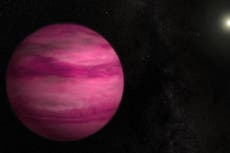Nasa simulation of the universe will guide future Webb telescope observations
To learn how to search the sky for never before seen distant galaxies, scientists will practice in virtual cosmos
When fully operational this summer, the James Webb Space Telescope will train its record-breaking optics on the distant darkness in the hope of imaging objects never seen before – the very first stars and galaxies to form in the universe less than 200 million years after the big bang.
But finding something that’s never been seen before in a big sky with a complicated space telescope isn’t quite as simple as pointing and clicking.
While some technicians and scientists are busy calibrating Webb’s instruments and optics, others are building a simulated universe in which to develop the sophisticated observation procedures for when Webb can begin searching for the real thing.
“Inputs from physically motivated simulations are essential to developing optimal observing strategies to achieve the specific scientific goals,” said Nasa Goddard Space Flight Center postdoctoral fellow Dr L. Y. Aaron Yung, in a Nasa blog.
Dr Yung and his colleagues create computer simulations of the universe from the ground up, first factoring in the role of dark matter and its impact on the formation and distribution of galaxies.
Dark matter is thought to make up 85 per cent of the matter in the universe, and although invisible, its mass and gravity help explain why the spread of galaxies in the cosmos looks like it does.
Dr Yung and other researchers then populate their simulation with galaxies based on known astrophysical processes and compare the results to known observations of the actual universe, such as the Hubble Space Telescope’s Ultra Deep Field survey.
They even create mock images of a survey of distant galaxies similar to what Hubble or Webb might return.
“Our simulated universe serves as the basis to create mock observing fields that are statistically similar to the observed universe,” Dr Yung said in the blog post. “We use them to provide predictions for galaxies beyond Hubble’s capabilities.”
By doing the simulated work now, in other words, scientists will have a better idea of where, and how, to look for real distant galaxies once Webb is ready.
More than 20 years in the making, the Webb telescope launched on 25 December and reached its operational orbit 1.5 million kilometers from Earth in deep space in late January.
Since then Webb team at the Space Telescope Science Institute, in Baltimore, has been busy aligning Webb’s 6.5-metre diameter, segmented primary mirror, and calibrating its exquisitely sensitive infrared instruments.
That commissioning process, as Nasa calls it, is expected to take months, with Webb not due to begin taking scientific observations until sometime over the summer.
Join our commenting forum
Join thought-provoking conversations, follow other Independent readers and see their replies
Comments


Bookmark popover
Removed from bookmarks